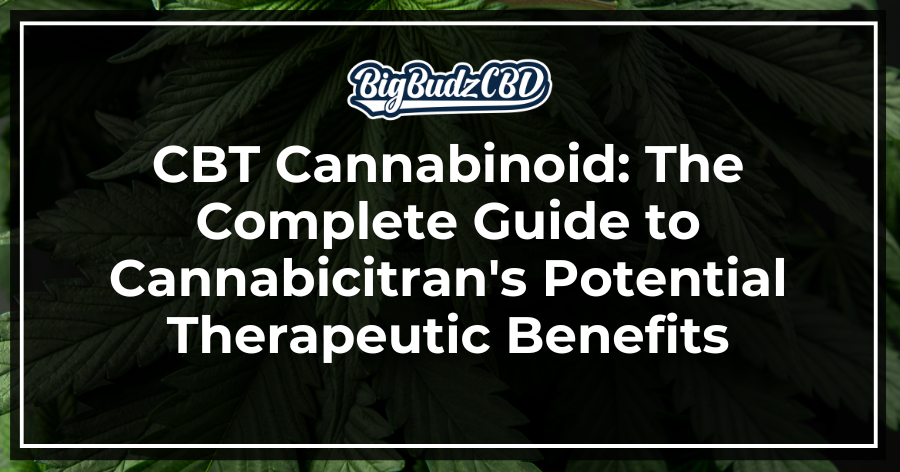Could a lesser-known cannabinoid unlock new therapeutic possibilities?
Scientists are looking into rare cannabinoids like Cannabicitran (CBT).
This non-psychoactive cannabinoid was first found in 1974.
It’s now being studied for its possible health benefits.
CBT is a rare cannabinoid found in small amounts in the cannabis plant.
It’s different from THC and CBD. Early studies suggest it could help with eye pressure, anxiety, and relaxation.
CBT has a unique chemical makeup. It’s made up of C21H30O2 and has a molar mass of 314.469 g·mol−1.
This makes it different from other cannabinoids. Studying it has been hard because it’s rare, but new methods are helping.
CBT could have many health benefits.
Scientists are looking into its role in pain relief, protecting the brain, and affecting appetite and metabolism.
As a non-psychoactive cannabinoid, it offers a way to use cannabis without feeling high.
It’s important to know about CBT’s legal status.
It’s not usually a controlled substance, but its laws are tied to cannabis laws.
This makes studying and developing CBT more complex.
Key Takeaways
- CBT is a rare, non-psychoactive cannabinoid first isolated in 1974.
- Early research suggests potential benefits in reducing intraocular pressure.
- CBT’s unique chemical structure sets it apart from other cannabinoids.
- Ongoing studies explore CBT’s therapeutic potential in various areas.
- The legal status of CBT is generally covered under cannabis regulations.
- Extraction and research of CBT are challenging due to its low natural abundance.
What is CBT (Cannabicitran) and How Does it Differ from Other Cannabinoids?
Cannabicitran (CBT) is a rare cannabinoid in cannabis plants.
It was first found in the early 1970s.
CBT is not as well-known as CBD and THC, but it’s getting more attention now.
Understanding CBT as a Minor Cannabinoid
CBT is a cannabinoid that doesn’t make you feel high.
It’s found in very small amounts in cannabis.
It comes from CBDa, like CBG and CBL.
Since 2019, scientists have been studying CBT because it’s so rare.
CBT vs CBD and THC: Key Differences
Here are the main differences between CBT and CBD and THC:
- CBT doesn’t crystallize, unlike CBD, making it useful in preventing CBD vape oil crystallization.
- Unlike THC, CBT is non-psychoactive and may even mitigate THC’s intoxicating effects.
- CBT shares some properties with CBD, such as potential tension-relieving and soothing effects.
| Cannabinoid | Psychoactive | Crystallization | Research Level |
|---|---|---|---|
| CBT | No | No | Limited |
| CBD | No | Yes | Extensive |
| THC | Yes | No | Extensive |
The Chemical Structure of Cannabicitran
CBT’s chemical structure is like CBD’s but different.
It comes from CBC, not CBGa like other cannabinoids.
This makes it special and could explain why it’s not intoxicating.
As scientists learn more about CBT, it’s becoming more interesting.
It could be a new kind of cannabinoid with unique benefits.
What Are the Potential Benefits of CBT Cannabinoid?
CBT, or Cannabicitran, is a rare cannabinoid that’s getting a lot of attention.
It has unique properties that make it different from CBD and THC.
Exploring CBT’s Therapeutic Potential
Researchers are looking into CBT’s benefits.
Early findings suggest it could help with pain, reduce swelling, and protect the brain.
It’s still being studied, but it looks promising for improving health.
CBT and Its Non-Psychoactive Effects
CBT doesn’t make you feel high like THC does.
This is good news for people who want to use cannabinoids but don’t want to feel altered.
It might even lessen THC’s effects when used together.
Potential Applications in Traditional Chinese Medicine
CBT is found in rhododendron, a plant used in Traditional Chinese Medicine.
This link to ancient practices makes people think about CBT’s role in today’s health practices.
| Potential Benefits of CBT | Current Research Status |
|---|---|
| Pain Management | Promising early results |
| Anti-inflammatory Effects | Under investigation |
| Neuroprotection | Emerging evidence |
| Stress Relief | Preliminary studies ongoing |
How is CBT Extracted from the Cannabis Plant?
CBT, or Cannabicitran, is a rare cannabinoid found in some cannabis strains.
It’s hard to get because it’s not common in the plant.
Researchers are finding new ways to get this special compound.
Extraction Methods for Rare Cannabinoids
Getting CBT and other rare cannabinoids is tricky.
Scientists use special methods to get them from the plant.
Some ways to do this include:
- Supercritical CO2 extraction
- Hydrocarbon extraction
- Ethanol extraction
These methods help get CBT without harming it.
As we learn more, we might find even better ways to do this.
CBT Content in Different Cannabis Strains
CBT is found in different amounts in cannabis strains.
It’s more common in hemp than in marijuana.
Strains with more CBD usually have more CBT.
The cannabis industry is working on making strains with more CBT for use.
Knowing where CBT is found helps growers and extractors.
This info is key for making products with lots of CBT for health and use.
| Strain Type | CBT Content | Extraction Difficulty |
|---|---|---|
| High-CBD Hemp | Moderate | Medium |
| Marijuana | Low | High |
| Industrial Hemp | High | Low |
As we get better at extracting and new strains come along, CBT’s use in health and wellness grows.
The future of CBT looks bright, with more research showing its special benefits.
What Does Current Research Say About CBT?
CBT research is still new, but recent studies have shown its promise.
Scientists are looking into how it might help with health issues.
However, they face challenges because it’s hard to find in cannabis.
Recent Studies on Cannabicitran
A 2007 study suggested CBT could lessen THC’s effects, like CBD does.
In 2011, researchers found a CBT-like substance in an old Chinese medicine plant.
A 1983 study looked into how CBT might help with eye pressure.
Limitations in CBT Research
There are big hurdles in CBT research:
- Rarity in cannabis plants (usually less than 0.3%)
- Regulatory barriers
- Limited funding compared to CBD and THC studies
These issues slow down our understanding of CBT.
But, ongoing trials are working to learn more about it.
| Aspect | CBT | CBD |
|---|---|---|
| Research depth | Limited | Extensive |
| Market size (2023) | Part of $11.5 billion minor cannabinoid market | Dominant in cannabinoid market |
| Psychoactive effects | Non-psychoactive | Non-psychoactive |
| Legal status | Not federally regulated | Legal if from hemp (<0.3% THC) |
Is CBT Legal and How Does its Legal Status Compare to Other Cannabinoids?
Understanding CBT’s legal status can be tricky, especially when comparing it to other cannabinoids.
Let’s look at the legal landscape and rules for CBT and its peers.
Current Legal Status of CBT
CBT is a hemp-derived cannabinoid. Its legal status is similar to cannabis rules.
Unlike THC, CBT is not a controlled substance.
The 2018 Farm Bill lets people grow and sell hemp products with less than 0.3% Delta-9 THC. This includes CBT.
CBT vs CBD and THC: Legal Considerations
There are big differences in the legal status of CBT, CBD, and THC:
- CBD: Legal when from hemp with less than 0.3% THC
- THC: Still a Schedule I drug federally, but legal in some places
- CBT: Legal like other hemp cannabinoids
It’s important to know your local laws.
Rules for hemp cannabinoids can change by state.
Some states don’t allow certain cannabinoids.
Always check local laws before buying or using CBT products.
As research on CBT grows, its legal rules might change.
Watch for updates from trusted sources.
This way, you’ll know the latest on CBT and other hemp cannabinoids.
How Can CBT Be Used and What Products Are Available?
CBT, a rare minor cannabinoid, is getting more attention in the cannabis world.
It’s not easy to find, but CBT products are starting to show up.
We’ll look at how people use CBT and what products are out there.
We’ll also talk about how much to take and staying safe.
Common CBT Products and Their Uses
CBT products are new but are becoming more common.
Here are some of the products you can find:
- Tinctures
- Capsules
- Gummies
- Vape products
CBT is also used in CBD vapes.
It stops crystals from forming, which is great for these products.
People use CBT for pain, stress, and to reduce inflammation.
Dosage and Safety Considerations for CBT
When thinking about how much CBT to take, be careful.
There’s not much research on it yet.
It’s best to start with a small amount and see how you feel before taking more.
Using CBT safely is like with other cannabinoids.
It won’t make you feel high like THC, but it could affect how other medicines work.
Always talk to your doctor before trying CBT.
| CBT Product | Typical Use | Safety Note |
|---|---|---|
| Tinctures | Sublingual administration | Start with 1-2 drops |
| Capsules | Oral consumption | Begin with lowest available dose |
| Gummies | Edible form | Start with half a gummy |
| Vape products | Inhalation | Use sparingly, monitor effects |
What’s the Future of CBT in Cannabis Research and Medicine?
The future of CBT in cannabis research is exciting.
Scientists are exploring its potential health benefits.
Cannabicitran (CBT) is getting attention for its special traits and health perks.
Potential Therapeutic Applications of CBT
CBT could be more than just rare. It might help with stress and pain.
It could also protect the brain and affect appetite and metabolism.
Unlike THC, it doesn’t make you feel high, which is good for those who want relief without the buzz.
Ongoing Research and Clinical Trials
Scientists are busy with clinical trials on CBT.
They’re looking into how it works with our body’s endocannabinoid system.
This could lead to new ways to treat health issues.
As we get better at making CBT, research will grow.
The future looks bright for CBT in medicine.
It could help with inflammation and even prevent cancer.
While we still have a lot to learn, CBT is showing promise in cannabis therapy.
CBT Cannabicitran FAQ
Here’s an extended FAQ for the topic “CBT Cannabinoid: The Complete Guide to Cannabicitran’s Potential Therapeutic Benefits” in the requested format:
Q: What is CBT and how does it compare to CBD?
A: CBT, or Cannabicitran, is a non-intoxicating cannabinoid found in cannabis plants.
Like CBD, CBT appears to have potential therapeutic benefits.
While research into CBT is still in its early stages, studies suggest that CBT may offer similar effects to CBD, including anti-inflammatory and analgesic properties.
However, more research is needed to fully understand CBT’s effects and how they compare to other cannabinoids like CBD and THC.
Q: What are the potential therapeutic benefits of CBT?
A: The potential therapeutic benefits of CBT are still being explored, but early research suggests that CBT may offer several promising effects.
These potential benefits include anti-inflammatory properties, pain relief, and neuroprotective effects.
Some studies indicate that CBT may also have potential in treating anxiety and depression.
However, it’s important to note that we don’t know enough about CBT yet to make definitive claims about its therapeutic benefits.
Q: How does CBT interact with THC and CBD?
A: While research into CBT’s interactions with other cannabinoids is limited, some studies suggest that CBT may work synergistically with THC and CBD.
This interaction, known as the “entourage effect,” may enhance the therapeutic potential of these cannabinoids when used together.
However, more research is needed to fully understand how CBT and THC, as well as CBT and CBD, interact within the body’s endocannabinoid system.
Q: Is CBT psychoactive like THC?
A: No, CBT is not psychoactive like THC. CBT is considered a non-intoxicating cannabinoid, similar to CBD.
This means that CBT does not produce the “high” associated with THC use.
The non-intoxicating effects of CBT make it a potentially attractive option for those seeking the therapeutic benefits of cannabinoids without the psychoactive effects of THC.
Q: How was CBT first discovered?
A: CBT was first isolated and identified in the 1960s by researchers studying the chemical composition of Cannabis sativa.
However, due to the focus on more abundant cannabinoids like THC and CBD, research into CBT has been limited.
In recent years, as interest in minor cannabinoids has grown, scientists have begun to explore CBT’s unique properties and potential therapeutic benefits more thoroughly.
Q: Are there different types of CBT?
A: While CBT itself is a specific cannabinoid, it can exist in different forms within the cannabis plant.
The two main types of CBT are CBT-A (the acidic form) and CBT (the neutral form).
CBT-A is converted to CBT through decarboxylation, a process that occurs naturally over time or can be accelerated by heat.
Both forms may have different properties and potential therapeutic benefits, but more research is needed to understand these differences fully.
Q: How does CBT compare to other minor cannabinoids like CBC and CBG?
A: CBT is one of many minor cannabinoids found in the cannabis plant, alongside others like CBC (Cannabichromene) and CBG (Cannabigerol).
While all these cannabinoids share some similarities, such as being non-intoxicating, each has its unique properties and potential therapeutic benefits.
For example, CBC has shown potential anti-inflammatory and anti-cancer properties, while CBG has demonstrated antibacterial and neuroprotective effects.
CBT’s specific benefits are still being researched, but early studies suggest it may have its own unique therapeutic potential.
Q: Is CBT legal?
A: The legal status of CBT can vary depending on its source and local laws.
In many places, CBT derived from hemp (cannabis plants containing less than 0.3% THC) is legal, similar to CBD.
However, if CBT is derived from marijuana (cannabis plants with higher THC content), it may be subject to stricter regulations.
It’s important to check your local laws regarding cannabinoids, as regulations can vary significantly between different countries and even between states within the same country.


























